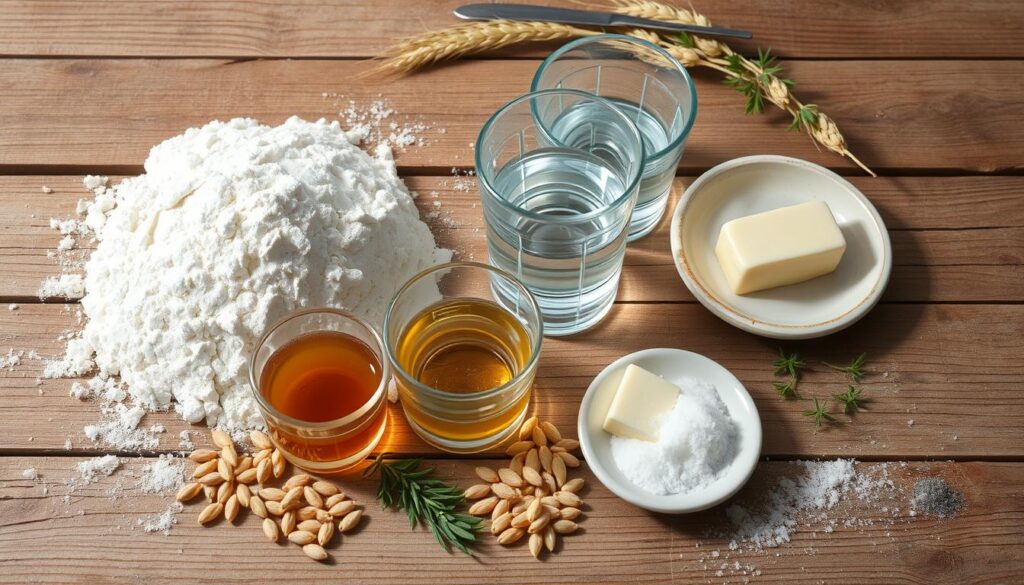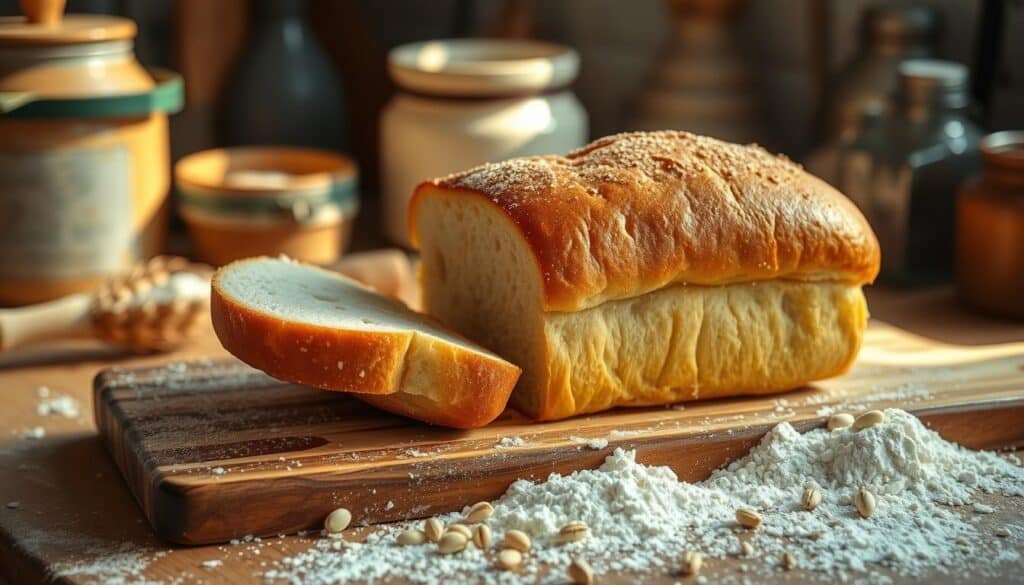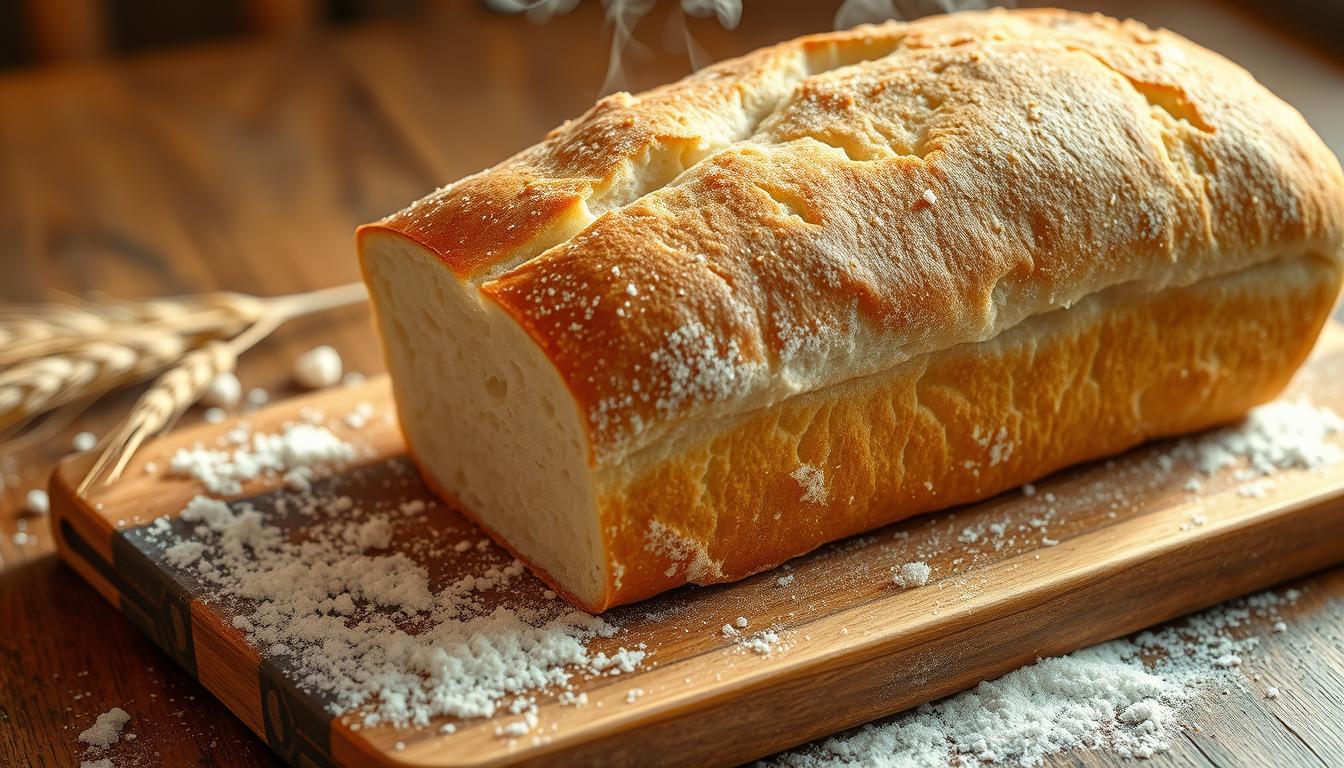Imagine the smell of fresh bread in your kitchen. The soft texture that feels like a cloud in your mouth. And the joy of making it all by yourself. That’s what happens when you make your own homemade sandwich bread.
It’s not just a fun activity. It’s also a way to make sure your family gets the best bread. You can pick the ingredients, so everyone loves what they eat.
Key Takeaways
- Homemade bread offers superior taste and texture compared to store-bought options.
- Making your own sandwich bread is a simple process that allows you to customize the ingredients.
- Homemade bread is versatile and can be used for sandwiches, toast, and a variety of other culinary applications.
- Baking your own bread at home can be a cost-effective and healthier alternative to purchasing pre-made loaves.
- The process of making homemade bread can be a rewarding and satisfying experience for home cooks of all skill levels.
Why Make Your Own Sandwich Bread at Home
Baking your own bread recipes at home has many benefits. It’s healthier and cheaper than buying bread from the store. Making your own yeast bread and artisan bread is a smart choice.For a complementary side dish idea, explore our Easy Southern Shrimp Boil Recipe.
Health Benefits of Homemade Bread
When you bake your own bread, you control what goes into it. You can avoid preservatives and additives found in store-bought bread. You can make it healthier by using whole grains and special flours.
Cost Savings Over Store-Bought Bread
Buying artisan bread and yeast bread from the store can be expensive. Making your own sandwich bread saves money. The ingredients are cheap, and the process is easy.
Controlling Your Ingredients
By making your own bread recipes, you choose every ingredient. You can pick the flour and add herbs and spices. This way, you get a bread that tastes just right for you.
“Baking bread at home is a deeply rewarding experience that allows you to savor the fruits of your labor in every slice.”
Key Ingredients for Soft Sandwich Bread
To make a soft and tasty sandwich loaf, we need to pick the right ingredients. Each part, from flour to yeast, is important for the bread’s texture and taste.
Types of Flour and Their Effects
The flour we choose affects the bread’s texture and crumb. All-purpose flour gives a good base. Bread flour, with more protein, makes the bread chewier. Adding whole wheat flour makes the loaf softer and adds a nutty taste.
Role of Yeast and Proper Usage
Yeast is key for making the dough light and airy. It’s important to let the yeast work right. We use active dry yeast and watch the dough rise to get the best texture.
Additional Ingredients for Enhanced Texture
- Fats, like butter or oil, make the bread soft and last longer.
- Sugars, like granulated or honey, feed the yeast and add sweetness.
- Milk, in liquid or powder, makes the bread tender and improves the crust.
Knowing how these ingredients work together helps us make a soft, fluffy sandwich loaf. It will make your homemade meals even better.For dessert pairing ideas, check out our 15 Easy Dessert Recipes You Can Make in 30 Minutes.

| Ingredient | Effect on Bread Texture |
|---|---|
| All-purpose Flour | Provides a balanced foundation |
| Bread Flour | Yields a chewier texture |
| Whole Wheat Flour | Lends a tender crumb and nutty flavor |
| Active Dry Yeast | Responsible for the bread’s rise and airy structure |
| Fats (Butter or Oil) | Contribute to softness and extended shelf life |
| Sugars | Provide food for the yeast and add subtle sweetness |
| Milk | Enhance tenderness and improve the crust |
Step-by-Step Sandwich Bread Recipe
Homemade sandwich bread is a great way to improve your bread baking skills. You’ll get to enjoy soft, fresh loaves right at home. Follow our easy guide to make the perfect homemade bread for your sandwich bread recipe.
- Gather your ingredients: all-purpose flour, active dry yeast, warm water, sugar, salt, and unsalted butter.
- In a large mixing bowl, combine the flour, yeast, sugar, and salt. Stir to combine.
- Add the warm water and melted butter to the dry ingredients. Mix the dough until it forms a shaggy mass.
- Turn the dough out onto a lightly floured surface. Knead for about 10 minutes, until it’s smooth and elastic.
- Place the dough in a greased bowl, cover with a damp towel, and let it rise for 1 hour or until doubled in size.
- Punch down the dough to release air bubbles, then shape it into a loaf. Place it in a greased 9×5 inch bread pan.
- Cover the pan and let the dough rise for another 30-45 minutes, until it has risen above the rim of the pan.
- Preheat your oven to 375°F (190°C).
- Bake the bread for 30-35 minutes, or until the crust is golden brown and the internal temperature reaches 195°F (91°C).
- Remove the bread from the oven and let it cool in the pan for 10 minutes. Then, transfer to a wire rack to cool completely before slicing.
Follow these simple steps, and you’ll have fresh, homemade sandwich bread in no time. You can add your favorite herbs, spices, or mix-ins to make it unique. Enjoy your delicious, homemade bread creation!For a refreshing drink to enjoy with your bread, explore our Dessert & Juices Collection.

Tips for Achieving the Perfect Rise
Getting your homemade sandwich bread to rise perfectly is key. It makes the bread light, fluffy, and even. We’ll share tips on proofing, temperature control, and solving common rising issues.
Proofing Techniques
First, make sure your dough proofs well. Let it rise in a warm, draft-free spot, like a turned-off oven with the light on. This helps the yeast work and the dough grow. Also, cover the dough with a damp towel to keep it moist.
Temperature Control Methods
Keeping the right temperature is vital for a great rise. The best proofing temperature for no-knead bread, bread baking, and yeast bread is 75-85°F. If it’s cooler, preheat your oven low, turn it off, and proof the dough inside.
Common Rising Problems and Solutions
Issues like underproofing or overproofing can affect your bread. Underproofing makes it dense and flat. Overproofing can cause it to collapse or not shape right. Adjust your proofing time and temperature to get a consistent, well-risen loaf.

